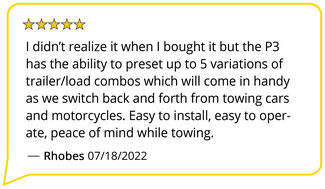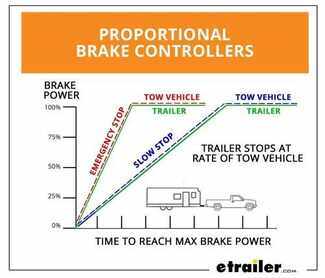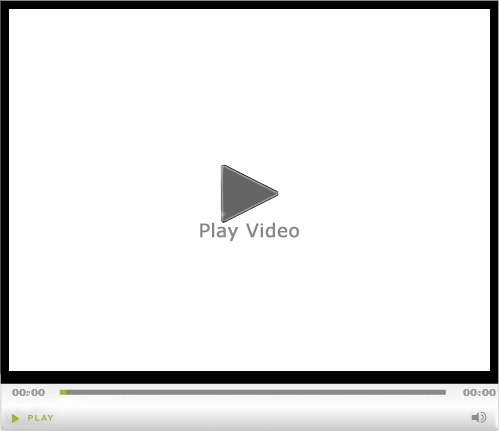

To see if this custom-fit item will work for you please tell us what vehicle you'll use it with.
The Tekonsha P3 is a brake controller beloved for its reliability and useability. You're able to save your settings and multiple profiles. It's easy to install, and with the custom harness, it's plug-and-play.
Features:
Specs:
Braking output is the maximum amount of power that will be applied to your trailer's brakes. How much braking output you need is determined by the weight of your trailer; a heavier trailer will need more power to bring it to a stop. You want to go as high as you can without the trailer brakes locking up.
Use the arrow buttons on the front of the module to set the output.
The boost setting controls the aggressiveness of your trailer's braking, meaning how quickly the brakes reach the maximum braking level. If your vehicle takes too long to come to a stop, increase the setting. If it stops too abruptly, decrease the setting.
Depending on the level of boost, your trailer brakes can start at either 13 percent or 25 percent of the set braking output. So instead of starting at 0, the brakes will start at 25 percent and get to 100 percent sooner. This keeps the trailer from pushing your tow vehicle forward.
Boost Levels:
| Approximate Gross Trailer Weight | Boost Level | Increase in Initial Power Output |
|---|---|---|
| Less than tow vehicle GVW | B1 | 13% |
| Equal to tow vehicle GVW | B1 or B2 | 13% or 25% |
| Up to 25% more than tow vehicle GVW | B2 or B3* | 25% |
| Up to 40% more than tow vehicle GVW | B3* | 25% |
*Both B2 and B3 offer a 25-percent boost in initial power. But the braking curve for B3 is more aggressive than that of B2. This means that, even though you will start out with the same intensity when using these boost levels, you will get an overall more aggressive braking experience with the higher level. So if you use B3, you will reach maximum braking sooner than if you use B2.
To engage the manual override, twist the rotary-style lever from right to left. This will activate the trailer's brakes and brake lights independently of your vehicle, great for stopping sway or controlling your trailer's momentum in an emergency.
The P3 is able to store your settings in multiple profiles so that you can have them ready to go for different trailers and drivers. Even the display is super customizable: you can change the screen color, brightness, and language to make it easy to use.
The P3 makes it easy to troubleshoot problems as they come up, with comprehensible and detailed diagnostics displayed on the screen.
Diagnostic troubleshooting messages include:
Diagnostic warning signs include:
The Prodigy P3 offers advanced safety features to prevent damage to various components of your towing setup.
-Integrated reverse battery protection shields the brake controller and your trailer's breakaway system from shorts.
-When the P3 is not in use, it draws only 3.6 milliamps, minimizing drain on your vehicle's battery.
-Any time your vehicle and trailer are at a standstill with the brakes applied for more than 5 seconds, the hold feature will kick on and reduce power to just 25 percent. This will keep your trailer in place without your brakes overheating.
Installing the P3 is incredibly simple. You'll mount the bracket to your dashboard then mount the unit to the bracket. Plug the custom harness into your vehicle and into the unit. Done!
Keep in mind that the P3 must be horizontally level and parallel with the direction of travel to work correctly.
With a replacement wiring harness (sold separately) and replacement bracket (TK5906 - sold separately), you can even transfer the Prodigy P3 to another vehicle.
Note: If you don't already have a 7-way plug at the back of your vehicle, take a look at our exclusive 7- and 4-way brake controller installation kit (ETBC7 - sold separately).
Proportional braking means that your trailer brakes mimic your tow vehicle's brakes. If you slam on the brakes, your trailer brakes will activate with the same intensity; if you brake lightly, your trailer brakes lightly too. The trailer's braking is in proportion to your vehicle and trailer.
The Prodigy P3 uses an internal inertia sensor to detect how your vehicle is braking so it can send the right amount of braking power to your trailer. It measures the inertia of your tow vehicle and activates the trailer's brakes to slow at the same rate. The result is uniform braking across your towing setup. No push-pull action - just smooth, proportional braking every time.
California residents: click here
Videos are provided as a guide only. Refer to manufacturer installation instructions and specs for complete information.
Today on our 2014 Dodge Durango, we're going to take a look at and show you how to install the Tekonsha Prodigy P3 Trailer Brake Controller. This proportional controller works for one up to four axles. It's part number is 90105. We're also going to be using the Tekonsha Plug-in Wiring Adapter, part number 3045-P. The manual override lever here on the bottom is a very convenient way to supply power back to your trailer without having to hit the brakes in your vehicle. We've got our gain adjustment here and wherever we've got that set, you can see we're at about 7.2 there; we can go up to 7.2. This manual override is at no time going to overpower the brakes back on the trailer.
In an emergency, if you grab it really quickly, you're not going to have to worry about it maxing out and locking up the brakes on your trailer. This will be set lower for lighter trailers on flatter terrain and then we want to move that up higher once our trailers get heavier or maybe we encounter some hilly terrain. Nice quick, easy adjustments can be made right here on the fly. Besides that, to also help us to fine tune the braking field, this top right button is going to be our boost level button. Right now it's set at off and you see it just indicates there a truck with a small trailer behind it. If we're going to go into boost level one, you can see now we're looking at a truck with a larger tandem axle trailer.
These boost levels set the quickness and aggressiveness in which our brakes are applied on the trailer. As our trailers get larger and larger, now we move into a tandem gooseneck on goose level two. On goose level three, you're going to have a very large trailer. These are going to help us adjust that to really fine tune that braking field as we're heading down the the road. Now the Prodigy P3, this is a proportional brake controller so unlike the time delayed systems, we don't have to wait on this to activate. As soon as we hit the brakes in our vehicle, this is going to recognize how we hit those brakes.
If we hit them aggressively, this is going to send power back to our trailer in that same manner, quickly, aggressively to get our trailer under control. If we're more into stop and go traffic and we stop here very lightly pushing on the brakes if we're just coming up to a normal stop light without aggressively braking, it's also going to sense that and it's only going to send back the power that we need so we're not overworking our braking system. Of course, the Prodigy P3 is going to offer vehicle battery rundown so our screen is not going to stay lit. It's going to time out and it's going to reduce the drain that we have on our battery. Built-in safeguards are going to protect the P3 from short circuiting. This is also going to help our trailer out, too.
If we get into a prolonged stop situation where we're sitting in a certain spot, after a few moments, the P3 is going to recognize that and it's slowly going to reduce the amount of braking power that's going back to the trailer so we don't overheat the system. In the menu, we have the adjustability of the display. We can change the color of it, the contrast, the brightness, depending on your situation. We can also set our brake tight so if we're doing either electric brakes or maybe electric over-hydraulic brakes, this is going to work out fine. We've got our help menu there. We can enter into there. If we need to troubleshoot, we've got "contact us" and even switch the language. The display, you'll see the brightness, the color and the contrast all available there. It's going to change as we move through it so you know exactly what you'll be looking at. The P3 is also going to offer five programmable settings for us so what we can do is set each one individually maybe for different trailers, different drivers. If you drive the vehicle sometimes and somebody else drives the vehicle sometimes, your preferences on how your trailer brakes might be a little bit different. It's just quick and easy to get in there and set them and then each time you get in, just hit your button and you'll be right back where you started. The first step in our installation is going to be to find the plug underneath the dashboard that matches our 3045-P. As you can see, this is going to have a plug that will go right into the connection on the brake controller. It's going to come right from our factory connector, which this will plug into. To find that, we need to look up here behind the emergency brake pedal. Some vehicles are going to have a felt panel down here. You can kind of see it here. We're going to get this pulled down and out of the way. We've got two push fasteners. We've got one located right here. If we come over, there will be another one right here in this area. Now to remove these, I'm going to use a trim panel tool. You could also use a screwdriver. I just want to get in behind the head of it there and just pull down. See there We'll pull that down and out of the way. It may have a little plug here for the light. You just take that off. We'll set this aside for now. If you look right back there, that's going to be our plug. The zip tie is kind of holding it in place there. Let's trim that so we can get it angled up here so we can work with it. There we go. Now on the back side of that plug or right above where that plug was located, that's our brake pedal arm. We don't want to get anything back behind there so we're going to run our plug . Our brake controller is going to be going over here on the right side of the steering wheel, so we know we want to plug over in this location. I'm going to run this up over a few of the braces that are up here on the dashboard. That way it will have plenty of support and a few things we can zip tie to up here. That floor vent would be a good area to use there. Now back on this side, we're just going to plug in our two connectors. Then I'm going to bring it up and we can zip tie it off right to this wire loop. Now we'll bring out as much as we need here of our pigtail to make our connection with our brake controller and then we can zip tie it off. Right underneath here is the vent for the floor heat or for the heat that hits your feet, so we'll go right around that, using a pretty good length zip tie. Once we have that where we can get to it easy, we'll bring out some and be able to bring a little bit back, just depending on how our connection needs to be. We'll want that to come out there and then we can put the panel back in that we removed earlier. All right, that should work out real well for us. Now we're going to be mounting our bracket right here. You'll see there's a little bit of wiggle space there so what we're going to do is just place a small washer right in behind it. I want to use the provided self-tapping screws and we want to use a quarter-inch bit driver. We decide where we want it and we'll just get those started. All right. That gives us a good, solid mounting location. The next thing we're going to do is take our small machine-thread screws. Those are going to thread in the hole on the side of the brake controller. Now this can be mounted anywhere you like at any kind of angle. I'm going to bring it up as close as I can and maybe as far inset as possible there. We'll go into that forward top hole. That should give us plenty of room for our leg and everything down below it there. I'll thread it in. There will be one on each side. We'll just grab our Phillips bit and tighten those on down. All right, that should be perfect, a nice, solid mount and easy to get to. I'll just bring our pigtail up. Now we can just plug our controller in. As you can see, it's going to light up there, indicating we've got all our connections, got good power. We've already got all our trailer connected or our trailer simulator, anyway, connected at the back. Now we can just operate the manual override there. You'll see it's going to be sending that signal and that power back to our tester or your trailer, if you've got your trailer hooked up. Now this is nice. This is going to give us constant diagnostic as we head down the road. In the event our trailer we're to come disconnected, you'll see that screen change and flash in a different color indicating to us that we have a problem that needs addressed. As soon as we get that corrected, it'll go right back to our normal operation screen. Now with everything working as it should, that's going to complete our installation of the Tekonsha Prodigy P3 Proportional Trailer Brake Controller, part number 90105, also using the Tekonsha Plug-in Wiring Adapter, part number 3045-P on our 2014 Dodge Durango.

Do you have a question about this Trailer Brake Controller?
Info for this part was:
At etrailer.com we provide the best information available about the products we sell. We take the quality of our information seriously so that you can get the right part the first time. Let us know if anything is missing or if you have any questions.
































Thank you! Your comment has been submitted successfully. You should be able to view your question/comment here within a few days.
Error submitting comment. Please try again momentarily.